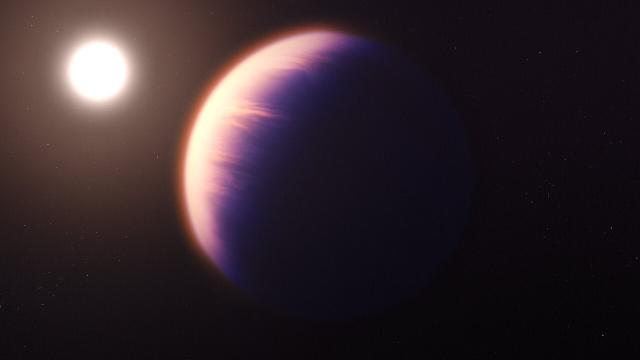Webb Space Telescope has detected “unequivocal” evidence of carbon dioxide in a distant exoplanet’s atmosphere, according to a European Space Agency release. According to the ESA, “it is the first clear, detailed, indisputable evidence” of carbon dioxide in a planet outside of our solar system.
The world is a gas giant — similar to Jupiter — about 700 light-years away. It’s called WASP-39 b and was first discovered in 2011, but only now were scientists able to train the Webb Telescope’s remarkable spectroscopic powers on the planet.
WASP-39 b is about as massive as Saturn but has a diameter about 33% larger than Jupiter’s, meaning it’s not very dense. The planet is hot; with a temperature of about 1,650 degrees Fahrenheit (900 degrees Celsius), a result of its intimate orbit around its host star.
Using Webb’s NIRSpec instrument, scientists are able to decipher the chemical composition of distant worlds. The instrument relies on the way exoplanets orbit their host stars; as the planets pass in front of the stars — or transit them — scientists see differences in the wavelengths of light that are blocked by the planet. When scientists scrutinised WASP-39 b, there was an indisputable signal of CO2.
“As soon as the data appeared on my screen, the whopping carbon dioxide feature grabbed me,” said Zafar Rustamkulov, a planetary scientist studying at Johns Hopkins University and member of the transiting exoplanet team, in the ESA release. “It was a special moment, crossing an important threshold in exoplanet sciences.”

Carbon dioxide comprises the majority of the Venusian and Martian atmospheres, but this is the first team scientists have so surely detected the molecule in an exoplanet’s atmosphere.
“Carbon dioxide molecules are sensitive tracers of the story of planet formation,” said Mike Line, a planetary scientist at Arizona State University and a member of the research team, in the same release. “By measuring this carbon dioxide feature, we can determine how much solid versus how much gaseous material was used to form this gas giant planet.”
The discovery is also a portent of what Webb can do in a narrow range of the mid-infrared spectrum, and indicates the telescope will be able to sniff out abundances of important gasses like methane in the future.
On July 12, the Webb team used a different spectrograph aboard Webb to reveal the presence of water in the atmosphere of WASP-96 b, a puffy gas giant 1,150 light-years away. The latest discovery regarding WASP-39 b adds another molecule — and planet — to Webb’s growing list of accomplishments.
As more exoplanets are put within the telescope’s sights, we’re bound to glean more insights about the diversity of worlds in our universe and how they form.
More: How the Webb Space Telescope Will Support the Search for Alien Life
